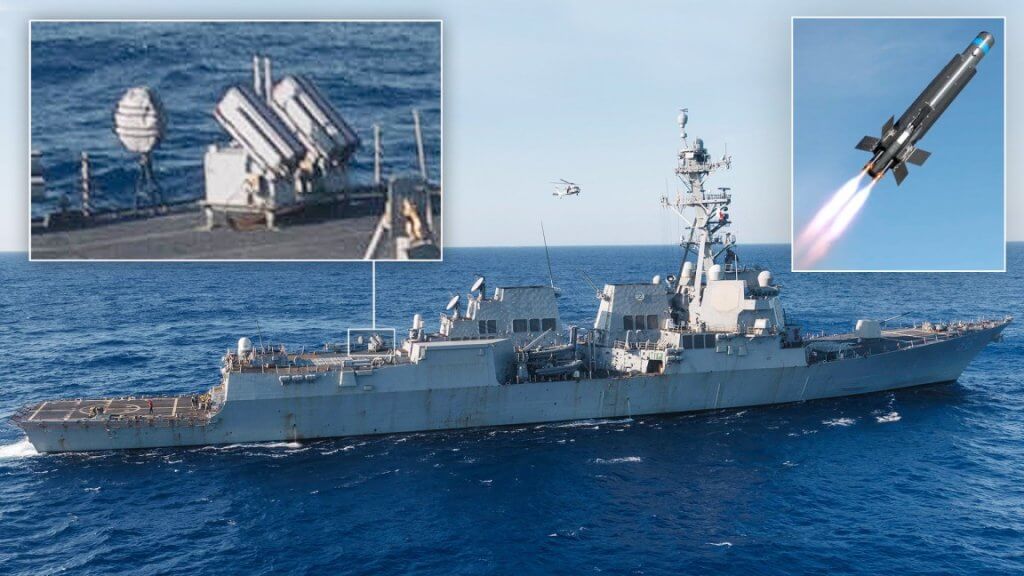
The U.S. Navy has quietly achieved a significant milestone in maritime defense with the operational deployment of cutting-edge counter-drone systems aboard the USS Bainbridge. Recent photographs taken on July 27, 2025, during NATO’s Neptune Strike exercise in the Ionian Sea, show the Arleigh Burke-class destroyer equipped with new Raytheon Coyote interceptor launchers—marking the first confirmed installation of these advanced systems on a U.S. Navy destroyer.
A Strategic Response to Evolving Threats
This development represents more than just a technological upgrade; it’s a direct response to the changing nature of maritime warfare. The Navy’s decision to equip destroyers with Coyote and Anduril Roadrunner-M counter-drone systems stems from harsh lessons learned in recent conflicts, particularly the Red Sea operations against Houthi drone attacks.
The cost-effectiveness issue has been stark: Navy ships were using multimillion-dollar Standard Missiles to intercept drones costing mere thousands of dollars. As one defense analyst noted, this created an unsustainable economic equation that threatened to drain naval missile magazines against relatively inexpensive threats.
Technical Capabilities and Advantages
The Coyote system brings several key advantages to naval defense:
Loitering Capability: Unlike traditional missiles that follow a direct intercept path, Coyote interceptors can loiter in designated areas, providing persistent coverage and the ability to engage multiple threats dynamically.
Cost-Effective Defense: Each Coyote interceptor costs significantly less than traditional surface-to-air missiles, making them ideal for countering low-cost drone swarms.
Flexible Deployment: The system’s ability to be launched from standard sonobuoy canisters provides installation flexibility across various naval platforms.
The companion Roadrunner-M system offers additional capabilities, including the revolutionary ability to return to base for reuse if not deployed against a target—a feature that further improves cost-effectiveness.
Operational Context and Deployment
The USS Bainbridge is one of three Arleigh Burke-class destroyers currently assigned to the Gerald R. Ford Carrier Strike Group, alongside the USS Winston S. Churchill and USS Mitscher. This strike group represents a testing ground for these new defensive capabilities, with the Churchill serving as the air defense commander—a role increasingly important as the Navy’s aging Ticonderoga-class cruisers are phased out.
The timing of this deployment is significant. The photograph was taken during a helicopter, board, search, and seizure drill as part of NATO exercises, demonstrating that these systems are being tested in realistic, multilateral maritime scenarios.
Broader Strategic Implications
This development signals several important shifts in U.S. naval strategy:
Magazine Depth Enhancement: These systems provide destroyers with additional interceptor capacity without consuming precious missile magazine space reserved for larger threats.
Scalable Defense Architecture: The ability to deploy both expendable (Coyote) and reusable (Roadrunner) interceptors provides commanders with flexible response options based on threat assessment.
Rapid Fielding Priority: The Navy’s decision to rush these systems to operational deployment indicates the urgency with which they view the drone threat
Technology Partners and Innovation
The partnership between established defense contractors and newer companies is noteworthy. While Raytheon provides the proven Coyote platform with its track record in hurricane research and military applications, Anduril Industries brings innovation with the Roadrunner series, representing a new generation of autonomous air defense systems.
Anduril’s Roadrunner platform introduces concepts like vertical takeoff and landing (VTOL) capability and high-G maneuverability, features that could revolutionize ship-based air defense by enabling interceptors to engage threats from multiple vectors.
Looking Forward
The USS Bainbridge installation represents just the beginning of what appears to be a broader transformation of naval air defense. With the Army already planning to purchase thousands of Coyote interceptors and the Navy moving to equip multiple destroyer platforms, we’re witnessing the emergence of a new defensive paradigm.
This evolution reflects the reality of modern naval warfare, where traditional high-end threats coexist with asymmetric challenges from inexpensive but numerous drone platforms. The success of these systems in operational deployment will likely influence similar adaptations across allied navies facing comparable threats.
As maritime operations continue to evolve, the integration of these counter-drone systems aboard frontline destroyers like the Bainbridge marks a critical adaptation—one that balances technological sophistication with economic sustainability in an era of emerging threats.

